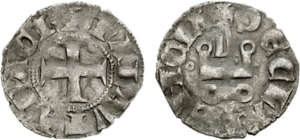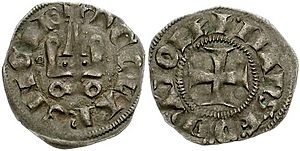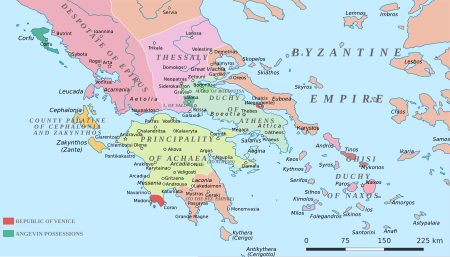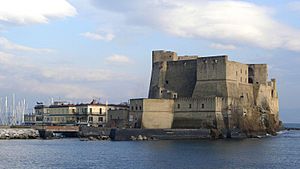Matilda of Hainaut facts for kids
Quick facts for kids Matilda of Hainaut |
|
|---|---|

Coin made when Matilda was in charge
|
|
| Princess of Achaea | |
| Reign | 5 July 1316 – 1321 |
| Predecessor | Ferdinand of Majorca |
| Successor | John of Gravina |
| Co-regent | Louis of Burgundy (1316) |
| Born | November 1293 |
| Died | 1331 (aged 37–38) Aversa |
| Spouse |
Guy II de la Roche
(m. 1300; died 1308)Hugh de la Palisse (m. c. 1320; died 1321) |
| House | Avesnes |
| Father | Florent of Hainaut |
| Mother | Isabella of Villehardouin |
Matilda of Hainaut (in French: Mathilde de Hainaut; born November 1293 – died 1331), also known as Maud or Mahaut, was the Princess of Achaea from 1316 to 1321. She was the only child of Isabella of Villehardouin and Florent of Hainaut. Her parents ruled Achaea together from 1289 to 1297.
After her father Florent died in 1297, Isabella ruled alone. She later married Philip of Savoy in 1300. King Charles II of Naples had a rule: Isabella could not marry without his permission. When Philip did not help the king in his wars, Charles took away their right to rule Achaea in 1307.
Matilda, who was only fourteen, tried to claim the land as her own. But the governor, Nicholas III of Saint Omer, refused. He waited for orders from Naples. Soon after, King Charles gave Achaea to his favorite son, Philip of Taranto.
Philip of Taranto did not spend much time in Greece. He made Matilda's husband, Guy II de la Roche, the governor. Guy died in 1308, making Matilda a widow. Philip then promised Matilda in marriage to his oldest son, Charles of Taranto.
In 1313, this promise was broken. Matilda instead married Louis of Burgundy. This was to make up for Philip of Taranto marrying Catherine of Valois. Catherine had been promised to Louis's brother, Hugh V, Duke of Burgundy. Philip of Taranto also gave up his rule of Achaea. He gave the Principality of Achaea to Matilda and Louis.
Before they could travel to Achaea, a man named Ferdinand of Majorca took control in 1315. Matilda and Louis arrived in Achaea in early 1316. They took back control after Ferdinand was defeated and died in the Battle of Manolada. Their shared rule did not last long. Louis died less than a month later, and Matilda became a widow for the second time.
The new king of Naples, Robert, wanted Achaea back for his family. In 1317, he suggested Matilda marry his brother, John of Gravina. Matilda refused because she did not want another political marriage. In 1318, Robert's messengers kidnapped the princess. They took her to Naples by force. She was made to have a wedding ceremony with John. But she refused to accept him as her husband.
In 1321, Matilda was brought before Pope John XXII. The Pope told her to obey Robert and marry John. But she still refused. Matilda then said she had already secretly married a knight named Hugh de la Palisse. No more attempts were made to marry her to John. But Robert could now take Achaea from her. This was because she had married without his permission. Robert also made up a story that Hugh tried to kill him. He said Matilda was involved. He used this as an excuse to put the princess in prison. Matilda spent the rest of her life as a prisoner. She was held first in the Castel dell'Ovo in Naples. Then she was moved to Aversa, where she died in 1331.
Contents
Matilda's Early Life and Family
Family and Achaea's Rulers
Matilda of Hainaut was born in November 1293. She was the only child of Isabella of Villehardouin and Florent of Hainaut. They ruled the Principality of Achaea together from 1289 to 1297. Matilda's mother, Isabella, was the oldest daughter of William of Villehardouin. William was Prince of Achaea from 1246 to 1278.
When William died in 1278, his family line ended. William had agreed that King Charles I of Naples and his family would be his heirs. This was part of a marriage agreement for Isabella. So, Charles became prince in 1278. By 1289, Charles I's son, King Charles II, ruled Achaea. Achaea was not rich and had many problems.
Local leaders suggested that Isabella and Florent should marry. King Charles II agreed and gave them the principality. But he had one rule: if Florent died, Isabella or any daughters could not marry again without the king's permission. If they did, the land would go back to the king.
A Young Princess's Marriages
When Florent died in early 1297, Matilda's mother, Isabella, became the sole ruler. Matilda was only three years old. To keep the principality safe, Isabella quickly arranged a marriage for Matilda. Matilda was married to Guy II de la Roche, the Duke of Athens. He had just become an adult.
The three-year-old Matilda was sent to Athens. But King Charles II did not approve the marriage. On July 3, 1299, he reminded Guy that Matilda needed royal permission to marry. He ordered her to be sent back to Achaea. Isabella and Guy had already asked Pope Boniface VIII to approve the marriage. The Pope said yes on August 9, 1299. So, King Charles II had to agree too, on April 20, 1300.
Isabella did not stay a widow for long. In 1300, she met Philip of Savoy in Rome. They married soon after. Pope Boniface VIII supported this marriage. King Charles II first disagreed. He reminded Isabella of the 1289 agreement. But he eventually gave in and made Philip the Prince of Achaea.
Relations between Charles and Philip got worse. Philip often refused to help the king in his wars. So, in 1307, Charles took away Philip and Isabella's right to rule Achaea. Philip had expected this. He had already gone back to his family's lands in Italy. He left the governor, Nicholas III of Saint Omer, in charge.
Matilda Claims Her Right
When her mother and stepfather lost their power, Matilda was about fourteen. She tried to claim the principality for herself. But Nicholas refused. He waited for orders from King Charles. Matilda's husband, Guy II, was very angry. He took parts of Thebes that Nicholas owned as revenge.
King Charles ignored Matilda's claim. He gave the principality to his younger son, Philip of Taranto. To make sure Isabella and Philip of Savoy did not try to get Achaea back, Charles offered them land in Italy. Isabella sadly had to accept. She died in 1312.
Isabella's will, written in 1311, said Matilda was the "heiress of all Achaea." Philip of Taranto did not stay in Achaea long. He left to fight a war and then returned to Naples. He made Guy, Matilda's husband, the governor. Guy's position as the real ruler of Achaea was stronger because he was married to Matilda. This gave him a link to the old ruling family.
Guy died from illness on October 8, 1308. He was the last of his family line. Matilda became a widow at a young age. To stop Matilda from trying to claim Achaea, Philip of Taranto promised her to his oldest son, Charles of Taranto.
Philip of Taranto's time as Prince of Achaea was short. In 1313, he married Catherine of Valois. She was the queen of the Latin Empire. Catherine had been promised to Hugh V of Burgundy. But this promise was broken. To make up for it, a marriage was arranged for Louis of Burgundy, Hugh's younger brother, and Matilda.
Matilda's promise to Charles of Taranto was broken. Matilda and Louis likely married on July 29, 1313. Philip of Taranto then gave all his rights to Achaea to Matilda and Louis. He became the Latin Emperor through his marriage to Catherine.
Fighting for Achaea

Louis was slow to travel to Greece. He had to stay in Burgundy until 1316. He needed to get ready and deal with his brother Hugh's death in 1315. During this time, others tried to claim Achaea. Matilda's aunt, Margaret of Villehardouin, claimed the principality. She said her father, William, had a will that gave her the land if Isabella died without children. But this document was likely fake.
The Kingdom of Naples and the local lords rejected Margaret's claim. To get support, Margaret married her daughter Isabella of Sabran to a prince named Ferdinand of Majorca. Margaret gave Ferdinand her claim to Achaea as her daughter's wedding gift. The lords of Achaea were angry. They attacked Margaret's castle and captured her. Margaret died in prison in 1315. Isabella of Sabran died two months later. But she and Ferdinand had a son, James. Ferdinand planned to fight for his son's claim.
In the summer of 1315, Ferdinand and his army landed near Glarentza. They defeated a small army sent to stop them. The people of Glarentza then said he was the new Prince of Achaea. Ferdinand was successful at first. He captured several forts and made his own coins. By early 1316, he controlled most of Achaea.
Matilda and Louis soon arrived to claim their land. Matilda arrived first. She traveled from Marseille to Navarino. She had 1,000 soldiers from Burgundy. At Navarino, she learned that the Archbishop of Patras and William I Sanudo, the Duke of Naxos, supported her. The governor, Nicholas le Maure, also promised his support. Soon after, Matilda's troops fought Ferdinand's army in the Battle of Picotin. Ferdinand won this battle.
Louis arrived in Achaea soon after. He brought his own soldiers from Burgundy. He also had troops from John I Orsini, the Count of Cephalonia. Louis also allied with Michael Kantakouzenos, the Byzantine governor of Mystras. Ferdinand asked for help from Athens and Majorca. But no help came. Louis decisively defeated Ferdinand on July 5, 1316, at the Battle of Manolada. Ferdinand was killed during or after the battle.
Matilda's Rule as Princess
Ruling Achaea
Matilda and Louis did not get to enjoy their victory for long. Less than a month after becoming rulers, Louis died. Some people thought John I Orsini of Cephalonia poisoned him. Louis's death left Matilda, at 23 years old and a widow twice, as the only ruler of Achaea. The land was still recovering from civil war. She also had enemies. The Byzantine Empire wanted to take back the whole area. The Duchy of Athens, ruled by Catalans, was also against the rulers from Naples.
Matilda's position was difficult. In early 1317, she could not send her own troops to protect her vassals in Euboea. They were being invaded by the Catalan Company. But she asked the Republic of Venice for help. Venice sent twenty warships to Euboea. They successfully fought off the Catalans for Matilda. Some papers suggest Matilda thought about giving Euboea to Venice.
Forced Marriage and Imprisonment
The new king of Naples, Robert, saw Matilda's difficult situation. Robert wanted his family to rule Achaea again. This was even though Philip of Taranto had given up the principality just three years before. Robert's plan was simple: marry his younger brother, John of Gravina, to Matilda.
In 1317, Matilda refused. She did not want another political marriage. Robert did not give up. He sent his messengers to take Matilda to Naples by force. In 1318, Robert forced her to have a wedding ceremony with John. John immediately called himself Prince of Achaea. But Matilda still refused to accept John as her husband.
To make John's rule seem right, Robert forced Matilda to choose. She had to either accept John as her husband or give up her rights to Achaea. This happened on June 13, 1318. Matilda's brother-in-law, Odo IV of Burgundy, protested for her. She also asked the Republic of Venice for help. But Venice did nothing. Odo was soon quieted when Philip of Taranto bought his claims. Matilda was allowed to go on a trip to Rome. But Robert watched her closely to make sure she did not escape.
Matilda was helpless and alone. In 1321, she was taken to Avignon. She was brought before Pope John XXII. The Pope ordered her to obey Robert and marry John of Gravina. But Matilda remained strong. She refused to marry John. This time, she said she had already secretly married Hugh de la Palisse. He was a knight from Burgundy whom she cared for very much. This secret marriage happened between 1318 and 1321. Hugh was probably one of the knights who came to Achaea with her husband in 1316.
This secret marriage meant she did not have to marry John. But Robert used it as an excuse to take the principality from her. Robert said she had married without his permission. This went against the 1289 agreement with her parents. In September 1322, Robert also made up a story. He said Hugh de La Palice tried to kill him, and Matilda was involved. So, Matilda was not only removed from power but also arrested for a made-up crime. On January 5, 1322, John of Gravina was officially made Prince of Achaea by Robert.
Imprisonment and Death
Matilda was imprisoned in the island castle Castel dell'Ovo in Naples. Hugh de la Palisse died in late 1321. In 1324, Matilda's cousin, William I, Count of Hainaut, offered Robert a lot of money for her release. But Robert ignored him. In 1325, King Charles IV of France also tried to help her. Robert ignored him too. In 1328, Matilda was moved from Castel dell'Ovo to the town of Aversa, near Naples.
Matilda died as a prisoner in 1331. She was only 38 years old. Robert paid for her funeral. She was buried in his family tomb in Naples. Matilda was the last person from her mother's family, the Villehardouin dynasty, to rule the Principality of Achaea. Her removal from power in 1321 and her death in 1331 marked the end of her family's rule in Greece.
Matilda had no children, even after many marriages. On her deathbed, she named her cousin James as her heir. James was the son of Ferdinand of Majorca, her old rival. This was her last political act. She chose to recognize the family line of the person she had fought against. She did not choose the family line of Robert and John of Gravina.
See also
 In Spanish: Matilde de Henao para niños
In Spanish: Matilde de Henao para niños



